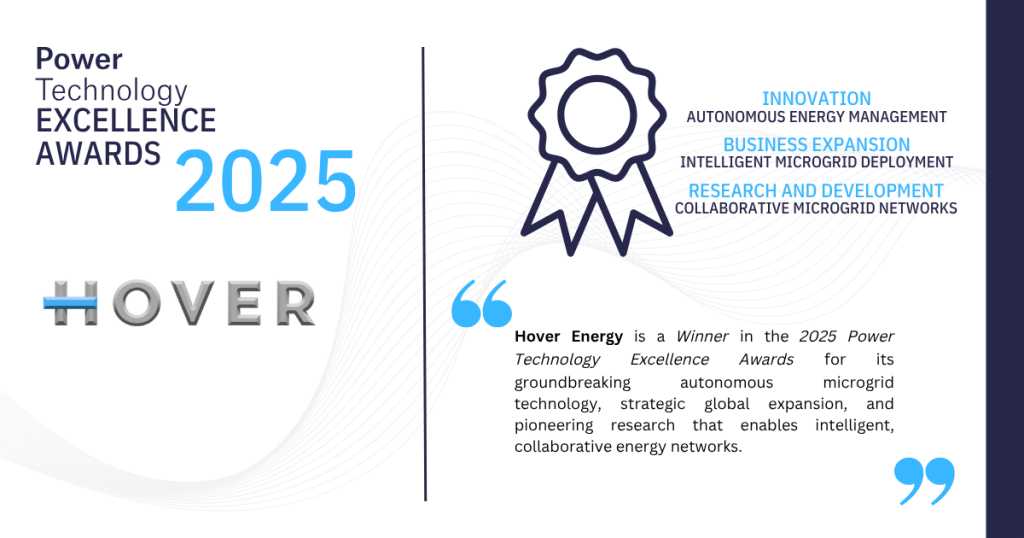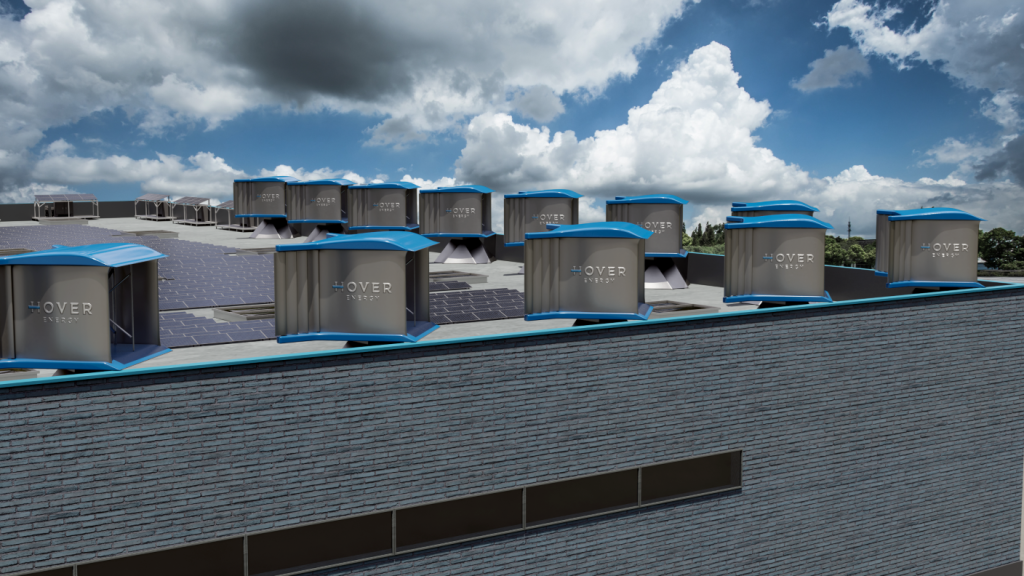Hover Energy’s CEO and Founder, Christopher Griffin, outlines how award-winning microgrid design, artificial intelligence (AI)-driven asset management, and multi-agent learning—co-created with IBM—are unlocking behind-the-meter efficiencies, accelerating partnerships, and scaling resilient, regulatory-ready deployments in the most compelling markets like Hawaii and the UK.
With collaborative testbeds, rigorous impact tracking, and a pipeline that includes a sustainable city project, Hover is positioning intelligent, connected microgrids at the center of the energy transition. The company was named a triple-category winner in the 2025 Power Technology Excellence Awards.

Discover B2B Marketing That Performs
Combine business intelligence and editorial excellence to reach engaged professionals across 36 leading media platforms.


PT: How have the recent industry awards influenced Hover Energy’s engagement with new markets or partners?
Christopher Griffin (CG): Winning these three awards has solidified our position as ‘The market leader in Microgrid Design and Development’ and helped us elevate our continued efforts to find new pathways to even greater efficiency behind-the-meter. Can’t wait to share what we’re working on for NEXT year!
In the meantime, we have multiple technical collaborations that have become full blown partnerships since these awards were announced, so perhaps there is a direct correlation.
PT: What were the biggest technical or operational hurdles Hover Energy overcame in deploying autonomous AI Agents across multiple microgrid sites?
CG: The deployment across multiple sites is currently in process, and the hurdles have been significant but not insurmountable. Technically, it is illegal to share power across property lines for non-DNOs, so connecting the sites digitally was the first step. Operationally, we are using storage to adapt the production to fit each site, and connecting the storage through the cloud is also not difficult. However, sharing AI data, for the purposes of each Agent learning from the other, has proven a bit more challenging than we hoped. Mainly because the sites are so different, thus the learnings in one are not necessarily applicable to the others, and therefore we are literally having to re-write how the training occurs between sites. It’s challenging, and actually really fun!
PT: How has the integration of AI-driven asset management changed day-to-day operations for your clients?
CG: This is where the surprise wins show up. Finding efficiencies, that no one predicted were available, is always a win-win. IBM’s MAS® 9.0 asset lifecycle management software, the foundational system on which our Microgrid Management SystemTM was designed, is their 9th version in 25+ years. Clearly, large corporations around the globe have been successfully installing it for decades for a reason. Now, the latest version of the software is being adapted and applied to microgrid assets and building assets simultaneously, and we are capturing efficiencies unachievable any other way. Our clients are thrilled with the additional resilience it provides.

PT: Could you elaborate on the decision-making process behind selecting new territories, such as Hawaii and Europe, for your latest microgrid deployments?
CG: The decisions for Hawaii and the UK as our target markets were easy. Both locations have excellent natural resources and high electricity costs. That makes every project financially viable for us. More importantly, both the political environment and business culture in these locations encourage on-site solutions that deliver true resiliency at the site level whether Hover is present or not. Stepping into a welcoming market has been encouraging for us and our partners. No question, we will expand in both markets for decades to come.
PT: How do you tailor your microgrid solutions to meet the regulatory and commercial requirements of different regions?
CG: Fortunately, we have designed the microgrid system architecture and selected assets—what we call the Energy Stack™—to meet the strictest global policy requirements, so typically, before we arrive at a location we have already addressed regulatory hurdles. That said, the market for deploying microgrids that incorporate an Energy Stack™ is ever changing, so we rely on excellent internal team members as well as attorneys and advisors who keep us abreast of changes. Importantly, we are members of a few organizations globally, e.g. The UK Business Council for Sustainable Development and the Emerge Alliance, who are leaders in policy, so we’ve kept our fingers on the pulse over the last couple of years regarding regulations. We intend to stay ahead of that curve, just as we have to date.
PT: What lessons have you learned from your testbed environments and field trials that have shaped the development of collaborative microgrid networks?
CG: We’ve proven what we have always believed and what is a cornerstone of our business model: we must collaborate. No one can solve all these issues by themselves. Connecting across networks, property lines, businesses, and regions should be a win for all parties. But people can be fearful of stepping out of a comfort zone, and thus it requires a thoughtful approach and meaningful dialogue along the way. The tech works. It is the people who require additional care. And we are fully prepared to take all the time needed to ensure every party involved is comfortable before doing anything. That’s just good business in the long run.
PT: How does Hover Energy’s approach to multi-agent learning set a new standard for predictive maintenance and energy sharing?
CG: Wow, well this is truly a groundbreaking effort that we have co-created with IBM. Using multiple agents focused at the component level ensures greater uptime, longevity, and performance of all electric generation assets. This is essential when deploying microgrids in limited spaces, as we are always pursuing every last percentage of efficiency we can capture. This takes that effort to an entirely new level, not seen in our industry to date. We are already blown away by the results.
PT: In what ways have partnerships with organizations like IBM and E.On accelerated your product roadmap or market access?
CG: Thanks to our colleagues at IBM, Siemens, and E.On, and now with our new Joint Ventures with Alternus and with SEE Holdings, we have fully integrated the wisdom and expertise that come with these industry-leading organizations. There is only so much we can become expert at doing, and the additional capacity, analysis, reach, and solution breadth we have gained, thanks to these incredible global businesses, cannot be overstated. These partners have changed Hover’s future.
PT: How do you ensure that these collaborations translate into tangible value for your end users?
CG: Through specific projects. The best way to capture value is through concrete work. We have all been a part of collaborations that are announced but never become valuable because the teams don’t spend the time actually working together to solve problems or create solutions. Too often, partnerships point fingers at other parties rather than at themselves. Entering these relationships with humility and without trying to one-up each other has been remarkably beneficial to both parties in each case mentioned. Why? Because we have immediately stepped into joint projects in which both parties benefit, unselfishly. That’s good collaboration, and great business.
PT: What role do local stakeholders play in the successful deployment and operation of your microgrid projects?
CG: Critical. It is absolutely essential to have local stakeholder buy-in! One great example is our excellent relationship with the University of East London. While working on a project for them, we heard that one of their post-doctoral students was losing their sponsor. We stepped up and offered to sponsor that person and their work if we could add an element that would focus on our microgrid’s operation as a study point. They agreed, we did so, and everyone wins! It’s an excellent way to combine technology, sustainability and education while all seeking to improve all three of those areas for each party. We love deals where there are no losers, and this is one of those stakeholder relationships that proved such.
PT: How does Hover Energy measure the environmental and economic impact of its microgrid installations?
CG: We use IBM software called Envizi, which measures all aspects of microgrid design, development, and operation and maps them to global frameworks (e.g. The United Nations’ SDGs) then sends a monthly progress report to stakeholders. Absolutely brilliant.
PT: What initiatives are in place to ensure your technology remains at the forefront of supporting global decarbonization efforts?
CG: Simple. First, Hover has a never-ending mission to find efficiency everywhere. Using WatsonX.ai and WatsonX.orchestrate, we are continually challenged to make improvements and find efficiencies. Secondly, we remain wildly curious about any and all technologies, never believing that we are ‘too cool’ to improve. We can always get better. And we will.
PT: What upcoming innovations or projects are you most excited to bring to market in the next 12–18 months?
CG: We have partnered with an incredible group to build a sustainable city. We are not publicly announcing this until December, but stay tuned: this project will be a groundbreaking exercise in design and integration aimed at creating social structures that improve lives. We’re very excited about it.
PT: How do you see the role of intelligent, collaborative microgrids evolving within the broader energy transition?
CG: I believe it is literally at the center of the transition. We must think differently if we want to live differently. It’s that simple; and Hover is doing it, one site at a time.

PT: How do you leverage industry awards and recognition to strengthen Hover Energy’s brand and stakeholder relationships?
CG: Poorly so far, honestly. We need to get better at this, especially since we have won so many and been recognized so many times over our 10-year history. Honor is important to both give and receive, and we are grateful for all that we have received.
PT: What message would you like the industry to take away from Hover Energy’s recent achievements?
CG: You haven’t seen anything yet—we’re just getting warmed up (pun intended).
PT: Christopher, thanks for the candid insights—from the nuts and bolts of cross-site AI training to the human side of collaboration. Your focus on measurable value, local stakeholder buy-in, and rigorous regulatory readiness offers a clear blueprint for scalable resiliency. We’ll be watching for December’s sustainable city reveal—and for how Hover’s multi-agent approach continues to redefine uptime, efficiency, and real-world impact across your expanding UK and Hawaii portfolios.





